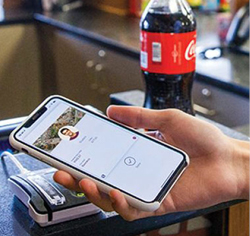When it comes to dining options, the possibilities are endless. You can DoorDash a steak and potato dinner, pick up “Mickey D’s” from the drive-thru, or opt for a grab-and-go meal at your local grocery store. You also have lots of dietary choices—from gluten-free and vegan, to plant-based and keto. College students, whether commuters or on-campus residents, expect all these options and more when they consider what to eat, and where to eat. Here are some deliciously different and inspiring dining choices offered by some of our Transact Mobile Ordering clients:
Sustainable and environmentally friendly
Eastern Michigan University’s on-campus dining halls feature several sustainable and “green” initiatives including using local purchasing and sustainable seafood programs; a “skip the straw” campaign to educate guests about plastic waste; plant-forward menus; and a 10-cent discount when you bring your own cup to one of their cafes.
“We minimize our impact on the environment with a primary focus on reduction. Our purchasing initiatives provide food choices which celebrate flavor, affirm cultural traditions, and support local communities,” their “Sustainability Commitment" reads.
Florida State University launched climate-friendly meal choices through its “Cool Food Badges” program. To encourage sustainable practices, “Cool Food Badges” identify dishes with a lower carbon footprint, such as their Zucchini Bolognese, Sweet Potato and Corn Flatbread, and Pesto Grilled Vegetable Wrap. The criteria are based on the item’s ingredients and the land used to produce the meal. If a dish’s carbon footprint fell below an established per-meal threshold and met a nutrition safeguard, it was approved as a "Cool Food” meal.
“Our campus has some of the most environmentally conscious students and they already know that we will go above and beyond to provide them with meals that are good for both people and planet," said Sarah Williams, sustainability coordinator for Seminole Dining.
Kennesaw State University, located in Kennesaw, Georgia, has been leading the pack in sustainability since they launched a Farm to Campus program in 2010. The school grows a quarter of its own produce, raises its own chickens and an apiary to produce honey used on campus. The program also recycles food waste via composting, vermiculture and, as if that weren’t enough, converts used cooking oil to biodiesel.
Santa Clara University’s dining service provider, Bon Appétit places a priority on "farm-to-fork," buying food from within a 150-mile radius to help support local farming and reduce transportation emissions. SCU has its own organic garden with a weekly farm stand. Other sustainable features include:
Cage-free eggs, hormone-free milk, and antibiotic-free chicken
Fair trade coffees and teas.
Free-range ground beef
Trayless dining
Ghost kitchens, oh my!
Ghost kitchens are food service operations with no wait staff, no dining room, and no parking lot. They’re physical spaces used to create food for off-premises consumption: basically, they’re restaurants without a storefront. Because many restaurants had to close their dining rooms during the pandemic, some pivoted and became ghost kitchens.
High Point University in High Point, North Carolina, opened its first “ghost kitchen” in 2021.
“Our students wanted another late-night option on campus, and we wanted to make it a fun and exciting experience. It’s our one and only fully mobile experience, and it’s easy and convenient for our guests to use,” said Kevin Summers, the university’s Director of Hospitality Services.
High Point’s ghost kitchen is next to their main residential dining location and is open Sunday through Thursday from 8 pm to midnight. Each night, the kitchen features one specialty menu served with a side item, cookie, and beverage. Examples of meals offered include mac and cheese bowls and tacos. Depending on the night, the kitchen takes anywhere from 50 to 150 orders.
“Our culinary team can be very creative at this location, and we can take the students’ feedback and mold the menu around their patterns,” Summers said.
Xavier University in Cincinnati, Ohio, operates three “ghost kitchens” on campus. “Our ghost kitchen menus are designed to be limited and require less staffing so they can be offered late at night with a smaller crew, giving students another after-hours dining option,” said Bryan Gutridge, Associate Director of Auxiliary Services at Xavier.
Students order from their ghost kitchens using Transact’s Mobile Ordering app.
“Currently the kitchens are “Melt Lab,” which offers an extravagant grilled cheese menu; “Fry Shack,” featuring a variety of loaded fry baskets,” and “Knot Your Average Pretzel,” offering jumbo or small pretzel bites with a variety of dippers and toppers,” Gutridge said.
“Mobile ordering has been around for more than a decade. The pandemic accelerated the self-checkout and ghost kitchen movement by a few years. These trends help to improve operational efficiency and reduce labor costs," said Fabian Raso, VP of Campus Commerce at Transact Campus.
Generation Z students (born between 1995-2012) want what they want. They expect to find environmentally friendly, sustainable dining options, and are accustomed to using tap-to-pay mobile ordering. To stay competitive, college campuses are responding by providing them with a better overall student experience. To learn more about seamless transaction processing and contactless mobile ordering, visit here.


